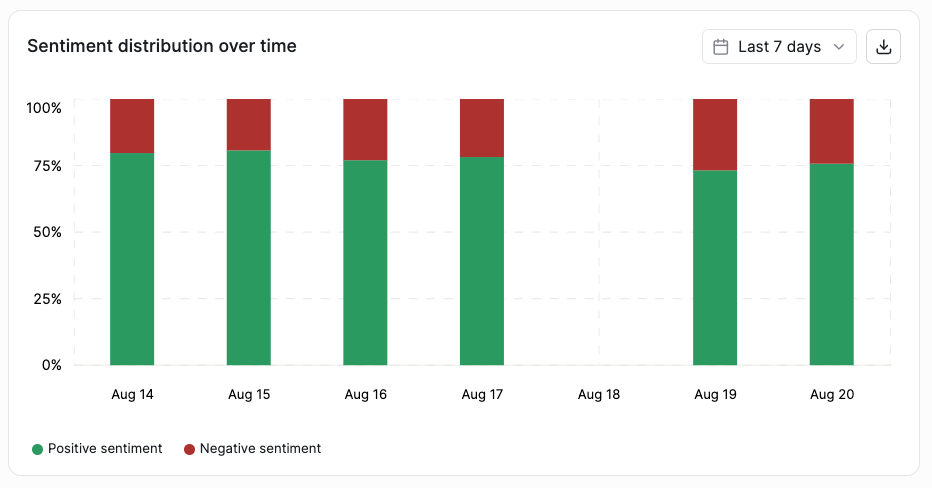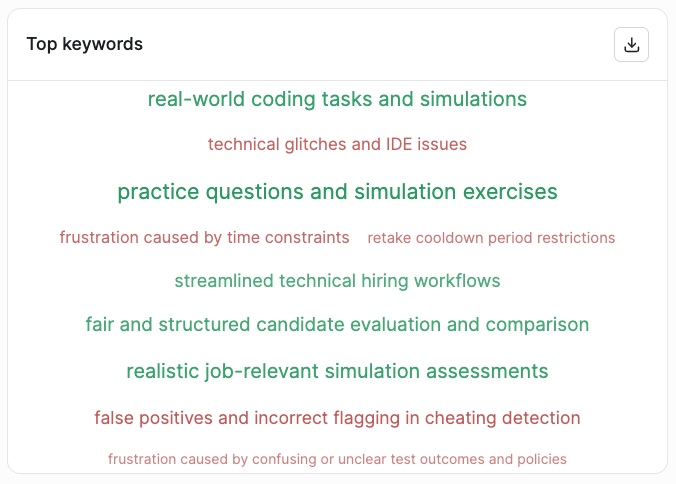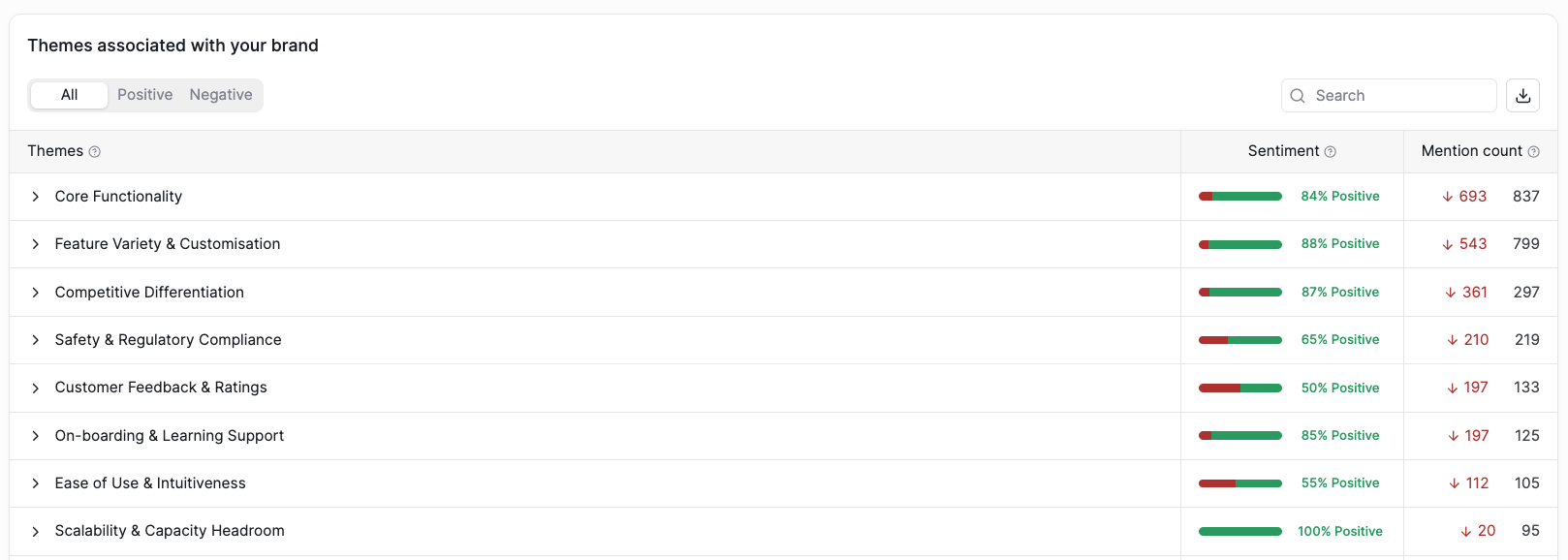Sentiment Analysis: All themes
A fast, at-a-glance way to see how AI talks about your brand—and whether that talk is positive or negative. The page groups AI-generated answers into recurring themes (ideas that keep showing up) and scores the sentiment for each. Use it to spot what’s resonating, what’s hurting, and what’s missing.

Key Concepts
Theme – A recurring topic that appears across AI answers to your configured prompts (e.g., Pricing, Ease of Use, Integrations).
Sentiment – The tone of those mentions. We show the Positive vs. Negative split per theme so you instantly know the vibe around each topic.
Positive Sentiment Keywords
This section displays the most frequently used positive terms associated with your brand across all analyzed content.
What this shows:
This component identifies and ranks keywords that appear in positively-rated content about your brand. Each keyword is accompanied by a frequency count showing how often it appears in positive contexts. The trending indicators (↑/↓) reveal whether the usage of these positive terms is increasing or decreasing over your selected time period, helping you spot emerging strengths or fading positive associations.
Why it matters:
- Identifies brand strengths that resonate with your audience, helping you understand what aspects of your offering generate enthusiasm
- Guides content strategy by revealing which positive attributes to emphasize in marketing materials
- Tracks campaign effectiveness by showing if your messaging successfully creates desired positive associations
Negative Sentiment Keywords
This section highlights terms that appear frequently in negatively-perceived content about your brand.
What this shows:
A compilation of keywords extracted from content with negative sentiment scores, quantified by their frequency of occurrence.
Why it matters:
- Early warning system for potential brand crises or customer dissatisfaction patterns
- Prioritizes improvement areas by highlighting the top negative themes and its associating keywords
- Enables proactive response to negative perceptions before they escalate into larger issues
Sentiment Distribution Over Time
A visual timeline showing the proportion of positive, neutral, and negative sentiment across your selected date range.

What this shows:
This stacked bar chart displays the percentage breakdown of sentiment categories for each time period in your analysis. Green sections represent positive sentiment, gray indicates neutral mentions, and red shows negative sentiment. Each bar totals 100%, allowing you to see not just the volume but the relative composition of sentiment at any given time. This visualization makes it easy to spot trend shifts, such as improving sentiment after a product update or declining perception during a service outage.
Why it matters:
- Tracks sentiment trends to identify if brand perception is improving or declining over time
- Correlates with events to understand how product launches, campaigns, or incidents affect brand sentiment
- Measures impact of reputation management efforts and strategic initiatives on public perception
Top Keywords
A comprehensive list of the most prominent terms associated with your brand, regardless of sentiment.

What this shows:
The most frequently mentioned keywords across all content about your brand, providing an unfiltered view of what people associate with your company. These keywords are ranked by total frequency across all sentiment categories, giving you insight into the dominant topics in brand conversations. Each keyword may be color-coded or labeled to indicate its predominant sentiment, helping you quickly assess whether key brand associations are positive or negative.
Why it matters:
- Reveals brand identity as perceived by your audience, not just as you intend it
- Uncovers unexpected associations that may require attention or leverage
- Informs SEO and content strategy by showing which terms naturally connect with your brand
Themes Associated with Your Brand
A detailed breakdown of thematic categories linked to your brand, with sentiment and mention metrics for each.

What this shows:
This component organizes all brand-related discussions into major thematic categories, presenting both the sentiment score (shown as a percentage of positive mentions) and the total mention count for each theme. The visual representation uses green bars to indicate sentiment strength, making it easy to identify which aspects of your brand perform well and which need attention.
Why it matters:
- Strategic prioritization by understanding which themes drive positive sentiment and which need improvement
- Resource allocation guidance based on theme importance (high mentions) and performance (sentiment score)
- Competitive positioning insights by seeing how different aspects of your offering are perceived
- Product development roadmap informed by user sentiment on specific features and capabilities
FAQs
Q: How often is the sentiment data updated?
A: Sentiment data refreshes based on your subscription plan, typically ranging from real-time to daily updates.
Q: What sources does the sentiment analysis cover?
A: The analysis aggregates data from multiple sources including social media, review sites, forums, news articles, and other publicly available digital content.
Q: Can I filter the data by specific time periods?
A: Yes, you can customize the date range using the date selector to analyze sentiment for specific periods, campaigns, or events.
Q: How is sentiment determined for each piece of content?
A: Advanced AI algorithms analyze text context, tone, and language patterns to classify content as positive, negative, or neutral.
Q: Can I export this data for reporting?
A: Yes, most dashboard views support data export in various formats for integration with your reporting tools.
Q: What's the difference between "Top Keywords" and theme-specific keywords?
A: Top Keywords show overall frequency across all content, while theme-specific keywords are filtered to show terms within particular topical categories.
Q: How should I interpret a high mention count with low positive sentiment?
A: This indicates a high-visibility area that needs improvement—it's frequently discussed but not positively perceived, representing both a risk and an opportunity.
Q: Can I drill down into specific themes for more detail?
A: Yes, clicking on individual themes typically provides deeper analysis with specific examples and trend data for that theme.
Q: What time period options are available for analysis?
A: You can typically select from preset ranges (last 7 days, 30 days, quarter) or define custom date ranges for specific analysis needs.
Q: How can I use this data to improve my brand strategy?
A: Focus on reinforcing themes with high positive sentiment, address themes with negative sentiment through targeted improvements, and monitor emerging themes to stay ahead of market trends.
Updated 4 months ago
